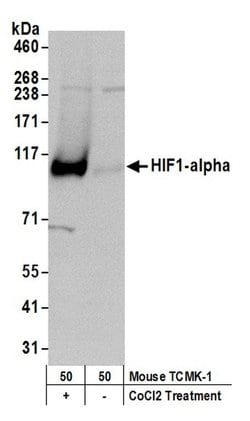Learn More
HIF1-alpha Polyclonal Antibody, Bethyl Laboratories
Rabbit Polyclonal Antibody
$151.31
Specifications
| Antigen | HIF1-alpha |
|---|---|
| Applications | Immunocytochemistry, Immunofluorescence, Immunohistochemistry, Western Blot |
| Classification | Polyclonal |
| Conjugate | Unconjugated |
| Form | Liquid |
| Catalog Number | Mfr. No. | Quantity | Price | Quantity & Availability | |||||
|---|---|---|---|---|---|---|---|---|---|
| Catalog Number | Mfr. No. | Quantity | Price | Quantity & Availability | |||||
50-155-7295

|
Bethyl Laboratories, Inc
A300286AT |
20 μL |
Each of 1 for $151.31
|
|
|||||
Description
The recommended shelf life for this product is 1 year from date of receipt. Based on 100% sequence identity, this antibody is predicted to react with Rat, Chicken and Bovine
HIF1-alpha (HIF1A) is a subunit of HIF1, which is a transcription factor found in mammalian cells cultured under reduced oxygen tension. HIF-1 is a heterodimer consisting of an alpha and beta subunit, both belonging to the basic-helix-loop-helix Per-aryl hydrocarbon receptor nuclear translocator-Sim (PAS) family of transcription factors. HIF1 functions as a transcriptional regulator of the adaptive response to hypoxia. Under hypoxic conditions, HIF-1 activates the transcription of over 40 genes, including erythropoietin, glucose transporters, glycolytic enzymes, vascular endothelial growth factor, HILPDA, and other genes whose protein products increase oxygen delivery or facilitate metabolic adaptation to hypoxia. HIF1-alpha regulates hypoxia-mediated apoptosis, cell proliferation and tumor angiogenesis. Hypoxia which induces p53 protein accumulation, directly interacts with HIF1-alpha and reduces hypoxia-induced expression of HIF1-alpha by promoting MDM2-mediated ubiquitination and proteasomal degradation under hypoxic conditions. Recent studies suggest that induction of NOX4 by HIF1-alpha contributes to maintain ROS levels after hypoxia and hypoxia-induced proliferation. In humans, it is located on the q arm of chromosome 14. The C-terminal of HIF1A binds to p300. p300/CBP-HIF complexes participate in the induction of hypoxia-responsive genes, including VEGF. Hypoxia contributes significantly to the pathophysiology of major categories of human disease, including myocardial and cerebral ischemia, cancer, pulmonary hypertension, congenital heart disease and chronic obstructive pulmonary disease.Specifications
| HIF1-alpha | |
| Polyclonal | |
| Liquid | |
| RUO | |
| TBS with 0.1% BSA and 0.09% sodium azide | |
| Hypoxia inducing factor 1 | |
| Between 775 and C-term | |
| Primary | |
| 4° C | |
| HIF1A |
| Immunocytochemistry, Immunofluorescence, Immunohistochemistry, Western Blot | |
| Unconjugated | |
| Rabbit | |
| Human, Mouse | |
| Q16665, Q61221 | |
| 15251, 3091 | |
| IgG | |
| Antigen affinity chromatography | |
| Antibody |
The Fisher Scientific Encompass Program offers items which are not part of our distribution portfolio. These products typically do not have pictures or detailed descriptions. However, we are committed to improving your shopping experience. Please use the form below to provide feedback related to the content on this product.
